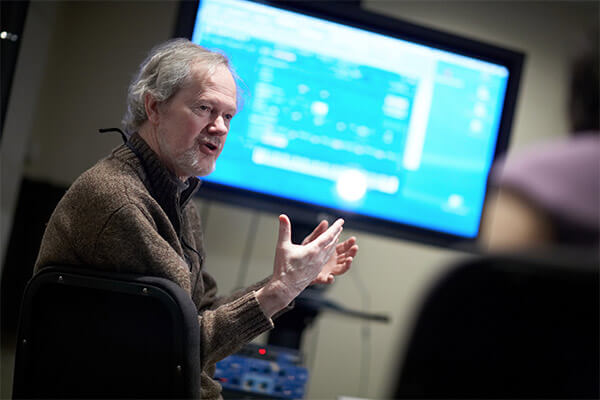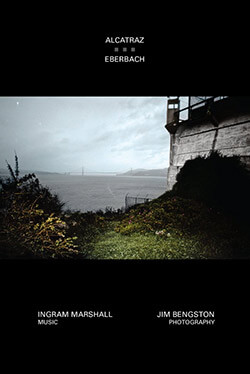 Composer Ingram Marshall and photographer Jim Bengston have joined the ranks of Steve Reich and John Adams with the new Starkland DVD presentation of their gripping multimedia works, Alcatraz (1982) and Eberbach (1985). These two pieces combine still photographs with live electronic music to explore the abandonment of two admittedly isolationist facilities: Alcatraz in the San Francisco Bay and Eberbach, a monastery in Germany’s Rhine Valley. Frequently in multimedia projects, one component assumes a role of prominence over the others, but this is certainly not the case with the brilliant co-operative efforts of Marshall and Bengston. It is clear that the works included on this DVD were thoroughly collaborative as the music and photography work in equal capacity to create a multi-sensory audience experience. The interplay of musical textures and manipulated images create a unique undefined genre of inseparable sounds and visuals.
Composer Ingram Marshall and photographer Jim Bengston have joined the ranks of Steve Reich and John Adams with the new Starkland DVD presentation of their gripping multimedia works, Alcatraz (1982) and Eberbach (1985). These two pieces combine still photographs with live electronic music to explore the abandonment of two admittedly isolationist facilities: Alcatraz in the San Francisco Bay and Eberbach, a monastery in Germany’s Rhine Valley. Frequently in multimedia projects, one component assumes a role of prominence over the others, but this is certainly not the case with the brilliant co-operative efforts of Marshall and Bengston. It is clear that the works included on this DVD were thoroughly collaborative as the music and photography work in equal capacity to create a multi-sensory audience experience. The interplay of musical textures and manipulated images create a unique undefined genre of inseparable sounds and visuals.

Alcatraz is a work in eight movements that approaches, explores, and departs the infamous facility that housed some of the most notorious criminals in the United States. Bengston’s genius image manipulation and use of crossfading creates movement through composite images that often make it impossible to discern where one image ends and the next begins. Marshall’s minimalist scoring also creates a layered texture that coincides seamlessly with Bengston’s visual presentation. The ‘introduction’ is the most texturally active and dissonant musical passage of the entire work. The work opens with a foreboding view of the island in the distance and arpeggiated figures reminiscent of Einstein on the Beach that invoke the surrounding waters. Marshall’s thick scoring dissipates, leaving only a solo piano line upon nearing the solitary prison in the following movement, ‘the approach.’ Images of barred doors and windows transform into one another, illuminating the uniformity of the prison cells. The uni-textural piano melodies enforce the homogeneity of the cells. The third movement, ‘inside,’ features pre-recorded sounds of clanking metal, footsteps, and closing doors that accompany images of the cells inside the facility. The thinner scoring and use of reverb coincides with the implicit isolation found in Bengston’s stark images. The isolation is further explored in ‘rules and regulations,’ where the sounds of wind and interwoven single sustained pitches over a synthesized persistent pulse simulate the solitary experience of the prisoners. The jarring change of pace in ‘cell doors’ features faster moving images of cell doors accompanied by the sounds of them slamming shut. The echo of the deafening percussive slams eventually becomes an ositnato rhythmic pulse. This ostinato fades as Marshall transitions to the Pärt-esque atmospheric soundscape of the sixth movement, ‘solitary.’ The return to a primarily piano-driven texture in ‘escape’ ushers in images containing color accents of green and purple as well as light coming in through the windows. The inclusion of color is quite striking as Bengston’s visual presentation is mostly black and white. Marshall’s eerie use of pitch bending seemingly invokes the ghosts of former inmates and guards past. The final movement, ‘end,’ returns to the opening synthesized texture as the images depart the facility and look back across the bay toward San Francisco.
 The two-movement companion piece included on this DVD, Eberbach, follows a similar visual course of approach and exploration of an abandoned facility, but Marshall’s contrasting approach to creating a soundtrack for these images demonstrates a distinction between the self-imposed isolation of a monastery and the forced isolation of a prison. This work featured a more consistent soundscape throughout, with the primary textures being strings, voices, and drones. Sounds of the wind, birds, bells, and hints of human voices establish the atmosphere of the monastery from an outside perspective in the first movement. The ringing of the bells becomes the more prominent texture as the images approach the outside walls. Once the photography takes us inside the structure, Marshall invokes the ghosts of monks with the use of voices while interjecting synthesized dissonances that illuminate the dichotomy between the reverent history and current abandonment. The second movement makes greater use of open fifths that are suggestive of early organum. The use of synthesized reverb invokes the acoustics of the monastery, and the lack of rhythmic pulse throughout creates a reflective environment in this sacred structure.
The two-movement companion piece included on this DVD, Eberbach, follows a similar visual course of approach and exploration of an abandoned facility, but Marshall’s contrasting approach to creating a soundtrack for these images demonstrates a distinction between the self-imposed isolation of a monastery and the forced isolation of a prison. This work featured a more consistent soundscape throughout, with the primary textures being strings, voices, and drones. Sounds of the wind, birds, bells, and hints of human voices establish the atmosphere of the monastery from an outside perspective in the first movement. The ringing of the bells becomes the more prominent texture as the images approach the outside walls. Once the photography takes us inside the structure, Marshall invokes the ghosts of monks with the use of voices while interjecting synthesized dissonances that illuminate the dichotomy between the reverent history and current abandonment. The second movement makes greater use of open fifths that are suggestive of early organum. The use of synthesized reverb invokes the acoustics of the monastery, and the lack of rhythmic pulse throughout creates a reflective environment in this sacred structure.
Marshall and Bengston succeed in weaving a narrative of these two abandoned spaces through collaborative sound and photography. The performance of these works through real-time image manipulation and live electronic sound processing is virtuosic to say the least. These two artists redefine the film/music relationship where neither component is relinquished to a supporting role. The exploration of this unique mixed-media genre is brilliantly presented on this DVD, allowing audiences to experience these works in a recorded format for the first time.
Ingram Marshall, Jim Bengston, Alcatraz (DVD/48 minutes, Starkland, 2013)
























